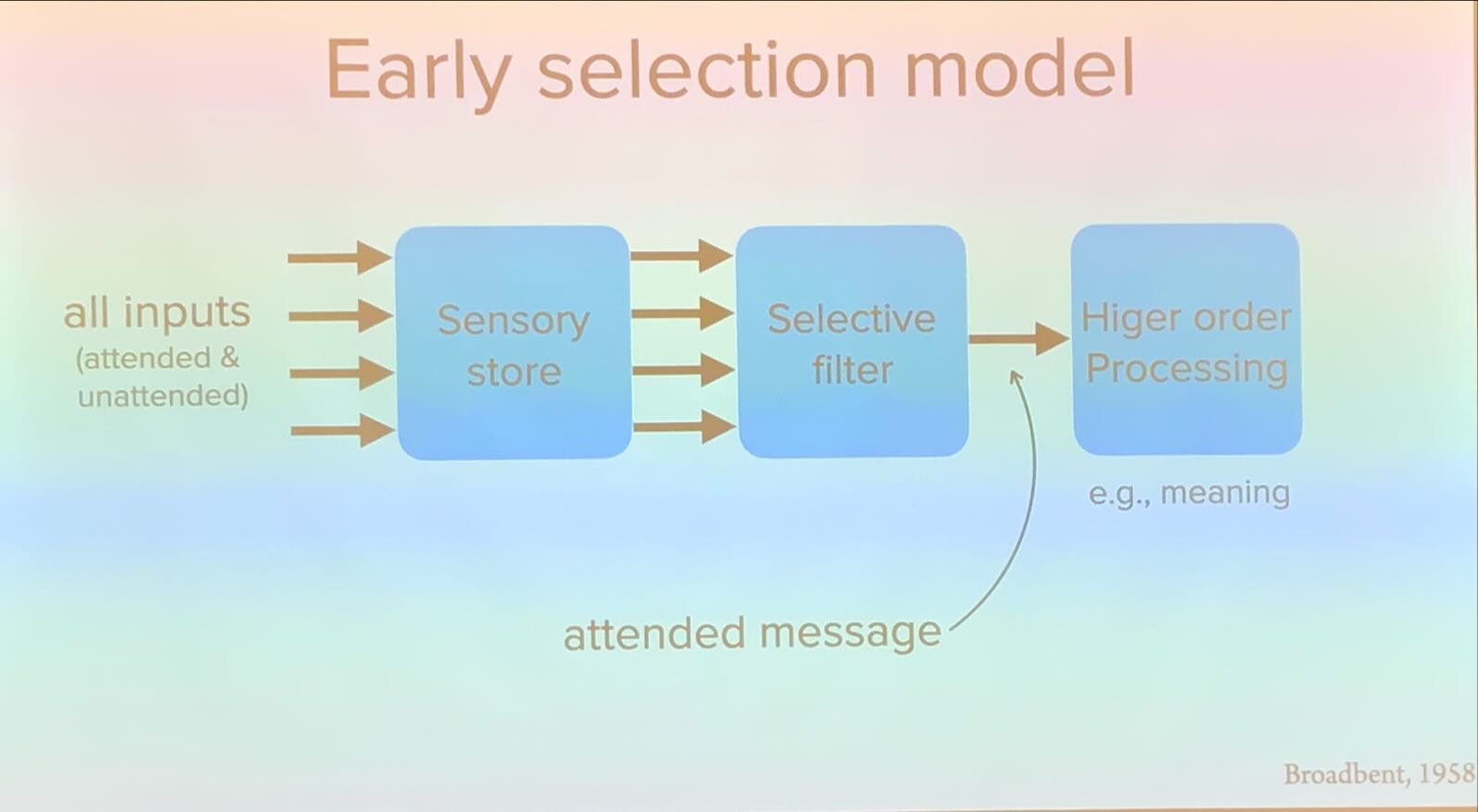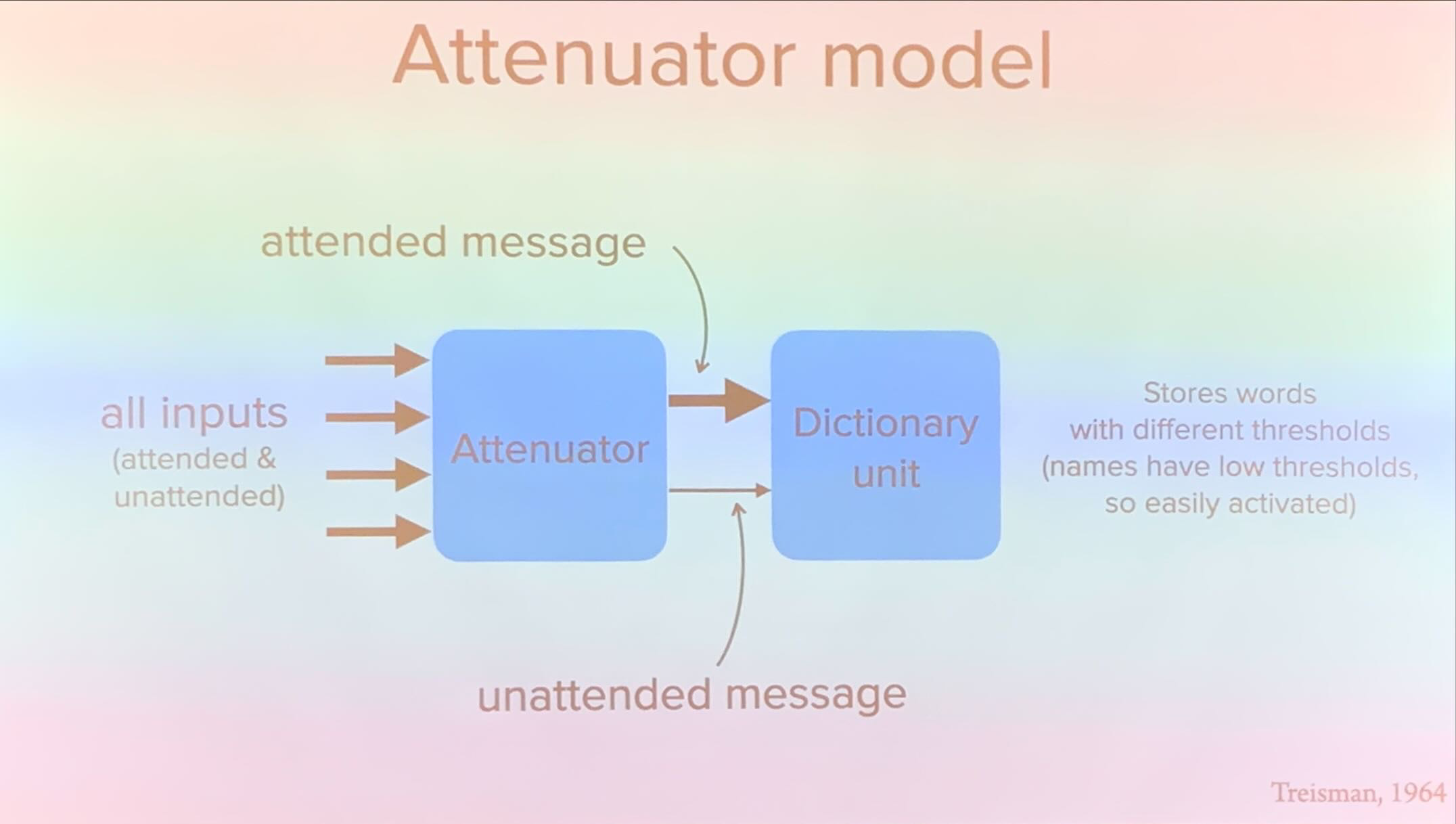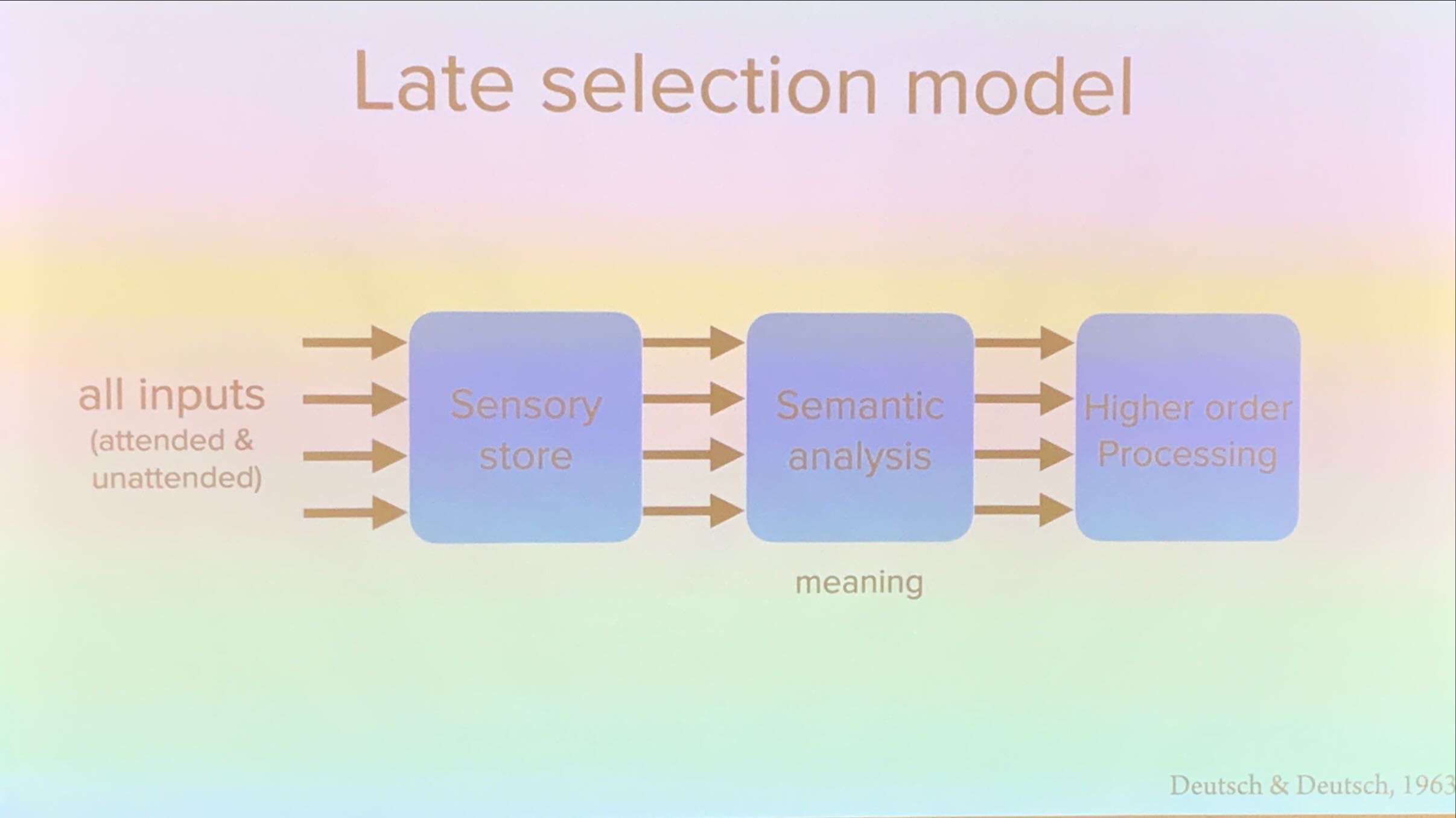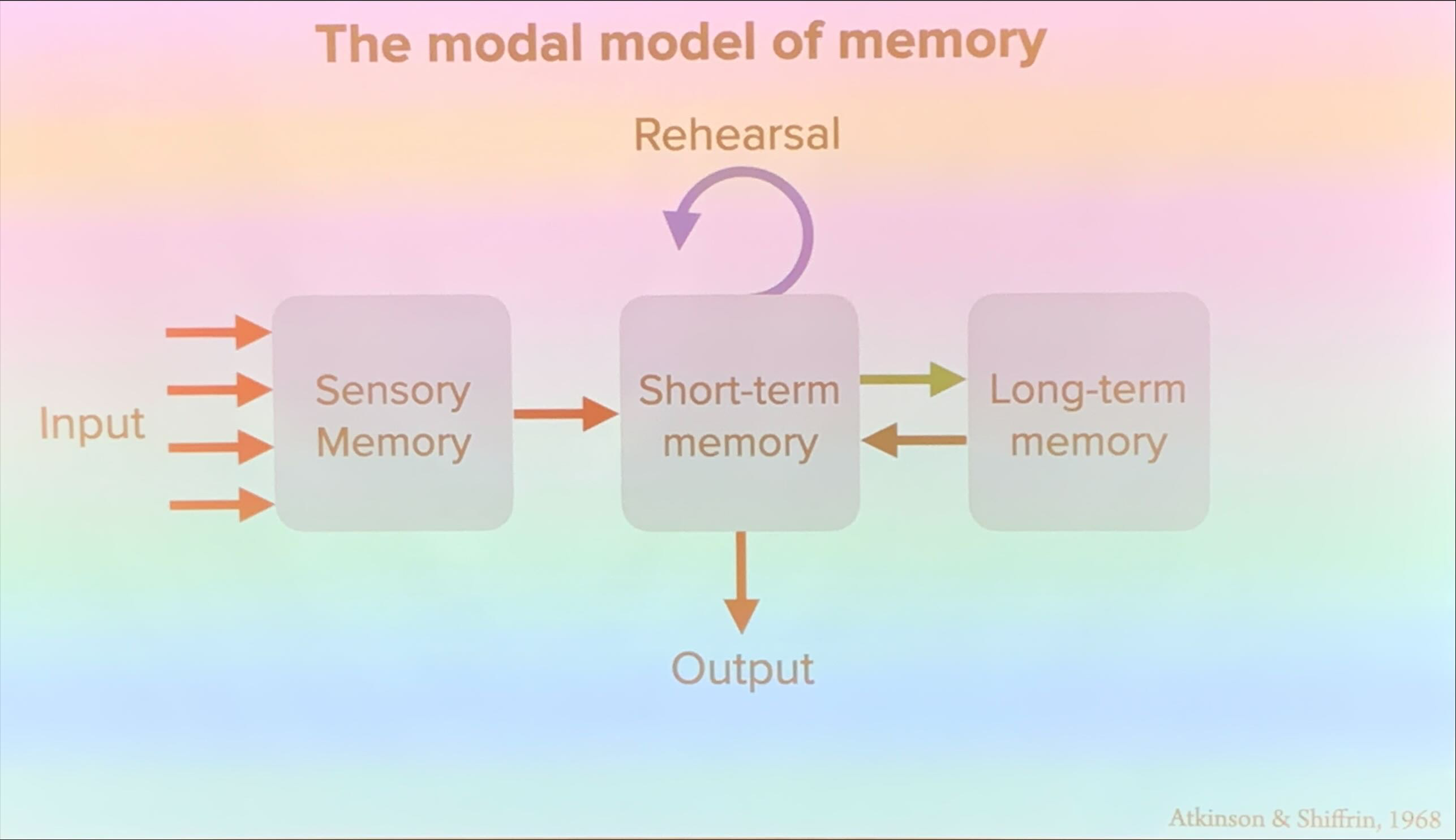Cognitive Psychology Exam #2
1/150
Earn XP
Description and Tags
Attention and memory. Ch. 4, 5, and 6 of the textbook
Name | Mastery | Learn | Test | Matching | Spaced |
|---|
No study sessions yet.
151 Terms
attention
the ability to focus on specific stimuli or locations.
selective attention
attending to one thing while ignoring others. Two types: endogenous and exogenous.
exogenous attention
caused by salient visual ‘events.’ Works fast and automatic. Hard to override. A bottom-up process. Motivationally relevant ‘events.’
Posner’s cueing task
participants see a cue, often an arrow, which may (valid) or may not (invalid) accurately predict the location of a target. They must quickly respond to the target's location or characteristics. The experiment helps study spatial attention, how cues affect attention, and the concept of "inhibition of return," which suggests attention may be briefly suppressed at a location it initially focused on. Valid cues lead to faster reaction times, while invalid cues slow down reactions. This highlights the role of cues in directing and inhibiting attention.
endogenous attention
two possibilities: enhancing relevant representation, suppressing irrelevant representations. Strategic, slower, can be overridden. A top-down process. Motivationally relevant goals.
Smith and Abrams motion onset experiment
study investigating the time required for perceiving motion in visual stimuli. Participants detected motion in a stimulus by indicating when they perceived it. Results showed that a minimum of 100 milliseconds is needed to perceive motion onset accurately. Therefore, RT motion onset < RT motion offset.
distraction
one stimulus interfering with the processing of another stimulus.
Anderson and Yantis 2011 experiment
Participants were shown a display with distractor and target stimuli. They had to identify the target while ignoring the distractors. Results showed that attention was captured by salient distractors, leading to slower response times and decreased accuracy in target identification. Additionally, results showed support for value-driven attentional capture: attentional is automatically captured by value, even if it is not relevant anymore.
Colby and Colberg 1999 experiment
participants had to look and attend to a light,
Seidl et al. 2011
Datta and DeYoe 2007
illusory conjunctions
once given a task, it is hard to focus on anything but that. Participants reported 20% illusory conjunctions. This effect disappeared when attentional load was reduced (Treisman 1980)
function of attention (according to Treisman)
enhanced processing of relevant information, binding features into objects
Cartwright Finch 2007
patient RM
illusory conjunctions on 23% of trailed even when viewing the objects for 10 seconds
hemispatial neglect
impairment attending to one side of space because of damage to right parietal cortex. Experiments testing this impairment include the ‘cross all the lines’ task and the ‘copy the drawing’ task. According to McGlinchee — Berroth et al. 1993, it is not due to a lack of visual processing.
divided attention
paying attention to more than one thing at a time.
attentional capture
a rapid shifting of attention usually caused by a stimulus such as a loud noise, bright light, or sudden movement.
visual scanning
movements of the eyes from one location or object to another.
Broadbent’s filter model of attention (early selection model)
the filter eliminates the unattended information right at the beginning of the flow of information.

dichotic listening
presenting different stimuli to the left and right ears. The participant’s task in this experiment is to focus on the message in one ear, called the attended ear, and to repeat what he or she is hearing out loud. The procedure of repeating the words as they heard is called shadowing. Results found that although participants could easily shadow a spoken message presented to the attended ear, and they could report whether the unattended message was spoken by a male or female, they couldn’t report what was being said in the unattended ear.
cocktail party effect
the ability to focus on one stimulus while filtering out other stimuli. Ex: at noisy parties people are able to focus on what one person is saying even if there are many conversations happening at the same time.
filter (in Broadbent’s model)
identifies the message that is being attended to based on its physical characteristics — things like the speaker’s tone of voice, pitch, speed of talking, and accent — and lets only this attended message pass through to the detector in the next stage. All of the other messages are filtered out.
detector (in Broadbent’s model)
processes the information from the attended message to determine higher-level characteristics of the message, such as its meaning. Because only the important, attended information has been let through the filter, the detector processes all of the information that enters it.
attenuator (Treisman’s attenuation model of attention)
analyzes the incoming message in terms of (1) its physical characteristics—whether it is high-pitched or low-pitched, fast or slow; (2) its language—how the message groups into syllables or words; and (3) its meaning—how sequences of words create meaningful phrases. Note that the attenuator represents a pro-cess and is not identified with a specific brain structure.
Treisman’s attenuation model of attention
once the attended and unattended mes-sages have been identified, both messages pass through the attenuator, but the attended message emerges at full strength and the unattended messages are attenuated—they are still present but are weaker than the attended message. Because at least some of the unattended message gets through the attenuator, Treisman’s model has been called a “leaky filter” model.

dictionary unit (Treisman’s attenuation model of selective attention)
contains words, stored in memory, each of which has a threshold for being activated.
late selection model of attention
proposed that most of the incoming in-formation is processed to the level of meaning before the message to be further processed is selected.

processing capacity
the amount of information people can handle and sets a limit on their ability to process incoming information.
perceptual load
related to the difficulty of a task. Some tasks, especially easy, well-practiced ones, have low perceptual loads; these low-load tasks use up only a small amount of the person’s processing capacity. Tasks that are difficult and per-haps not as well practiced are high-load tasks and use more of a person’s processing capacity.
load theory of attention
with the low-load task, there is still processing capacity left. This means that resources are available to process the task-irrelevant stimulus (like the cartoon character), and even though the person was told not to pay attention to the task-irrelevant stimulus, it gets processed and slows down responding.
stroop effect
it is harder to name the colors of the words than the colors of the shapes. This effect occurs because the names of the words cause a competing response and therefore slow responding to the target—the color of the ink. The task-irrelevant stimuli are extremely powerful, because reading words is highly practiced and has become so automatic that it is difficult not to read them.
overt attention
shifting attention from one place to another by moving the eyes.
stimulus salience
the physical properties of the stimulus, such as color, contrast, or movement.
covert attention
shifting attention while keeping the eyes still.
inattentional blindness
when people are unaware of clearly visible stimuli if they aren’t directing their attention to them.
visual search
scanning a scene to find a specific object.
inattentional deafness
focusing on a difficult visual task results in impaired hearing.
change detection
one picture is presented followed by another picture, and the task is to determine what the difference is between them.
change blindness
difficulty in detecting changes in scenes.
binding
the process by which features such as color, form, motion, and location are combined to create our perception of a coherent object
feature integration theory
theory proposing that attention is required to bind individual features of an object together into a unified perception. It suggests that attention is needed to combine features like color, shape, and motion to form a coherent whole. This theory explains how our brain integrates different features to create a complete and meaningful perception of the world.
preattentive stage (of the feature integration theory)
occurs before we focus attention on an object. Because attention is not involved, researchers argue that this stage is automatic, unconscious, and effortless. In this stage, the features of objects are analyzed independently in separate areas of the brain and are not yet associated with a specific object.
focused attention stage (of the feature integration theory)
attention is focused on an object and the independent features are combined.
illusory conjunctions
combinations of features from different stimuli. Can occur even if the stimuli differ greatly in shape and size.
Balint’s syndrome
inability to focus attention on individual objects due to damage to parietal-occipital lobes on both sides resulting in an impairment in focusing attention and an impairment with feature integration.
conjunction search
to search for a combination (or conjunction) of two or more features in the same stimulus—“horizontal” and “green.” You couldn’t focus just on green because there are vertical green lines, and you couldn’t focus just on horizontal because there are horizontal red lines. You had to look for the conjunction of horizontal and green. Useful for studying binding because finding the target in a conjunction search involves scanning a display in order to focus attention at a specific location.
ventral attention network
controls attention based on salience.
dorsal attention network
controls attention based on top-down processes.
effective connectivity
refers to how easily activity can travel along a particular pathway.
memory
the process involved in retaining, retrieving, and using information about stimuli, images, events, ideas, and skills after the original information is no longer present. It is active any time some past experience has an effect on the way you think or behave now or in the future.
modal model of memory
proposed three types: sensory memory, short-term memory, and long term memory.

control processes
dynamic processes associated with the structural features that can be controlled by the person and may differ from one task to another.
rehearsal
repeating a stimulus over and over.
sensory memory
the retention, for brief periods of time, of the effects of sensory stimulation. We can demonstrate this brief retention for the effects of visual stimulation with two familiar examples: the trail left by a moving sparkler and the experience of seeing a film. Unlimited/very large capacity and automatic.
persistence of vision
the continued perception of a visual stimulus even after it is no longer present. This persistence only lasts for a fraction of a second.
delayed partial report method
the letters were flashed on and off and then the cue tone was presented after a short delay. The result of the delayed partial report experiments was that when the cue tones were delayed for 1 second after the flash, participants were able to report only slightly more than 1 letter in a row. Sperling concluded from these results that a short-lived sensory memory registers all or most of the information that hits our visual receptors, but that this information decays within less than a second.
iconic memory
the brief sensory memory for the visual stimuli.
echoic memory
persistence of sound. It lasts for a few seconds after the presentation of the original stimulus.
short-term memory
the system involved in storing small amounts of information for a brief period of time. It is dependent on the maintenance of neural activity.
digit span
the number of digits a person can remember.
change detection
the display on the left was flashed for 100 ms, followed by 900 ms of darkness and then the new display on the right. The participant’s task was to indicate whether the second display was the same as or different from the first. (Notice that the color of one of the squares is changed in the second display.) This task is easy if the number of items is within the capacity of STM but becomes harder when the number of items becomes greater than the capacity of STM.
chunking
small units (like words) can be combined into larger meaningful units, like phrases, or even larger units, like sentences, paragraphs, or stories. Performance depends on how information is chunked. This is why capacity estimates can vary from 4 to many more.
chunk
a collection of elements that are strongly associated with one another but are weakly associated with elements in other chunks.
working memory
a limited-capacity system for temporary storage and manipulation of information for complex tasks such as comprehension, learning, and reasoning.
phonological loop
consists of two components: the phonological store and the articulatory rehearsal process. It holds verbal and auditory information. Thus, when you are trying to remember a telephone number or a person’s name, or to understand what your cognitive psychology professor is talking about, you are using your phonological loop.
phonological store
has a limited capacity and holds information for only a few seconds.
articulatory rehearsal process
responsible for rehearsal that can keep items in the phonological store from decaying.
visuospatial sketch pad
holds visual and spatial information. When you form a picture in your mind or do tasks like solving a puzzle or finding your way around campus, you are using your visuospatial sketch pad. The phonological loop and the visuospatial sketch pad are attached to the central executive. STM system independent from phonological loop. Has capacity in objects and visual features. Interference by competing visuospatial tasks
central executive
where the major work of working memory occurs. It pulls information from long-term memory and coordinates the activity of the phonological loop and visuospatial sketch pad by focusing on specific parts of a task and deciding how to divide attention between different tasks. It is therefore the “traffic cop” of the working memory system. Required for control. Regulates the refreshing or rehearsal processes. Focus, divide, and switch attention. Connects with LTM. The most important but least understood component of working memory.
phonological similarity effect
the confusion of letters or words that sound similar.
word length effect
occurs when memory for lists of words is better for short words than for long words.
articulatory suppression
the repetition of an irrelevant sound which reduces memory because speaking interferes with rehearsal.
visual imagery
the creation of visual images in the mind in the absence of a physical visual stimulus.
mental rotation
rotating an image of one of the objects in their mind. An example of the operation of the visuospatial sketch pad because it involves visual rotation through space.
persevation
repeatedly performing the same action or thought even if it is not achieving the desired goal.
episodic buffer
can store information (thereby providing extra capacity) and is connected to LTM (thereby making interchange between working memory and LTM possible). Integrates visual, spatial, and verbal information. Retrieval occurs through awareness. Links to LTM and semantic meaning
delayed-response task
required a monkey to hold information in working memory during a delay period. The monkey sees a food reward in one of two food wells. Both wells are then covered, a screen is lowered, and then there is a delay before the screen is raised again. When the screen is raised, the monkey must remember which well had the food and uncover the correct food well to obtain a reward. Monkeys can be trained to accomplish this task. However, if their PFC is removed, their performance drops to chance level, so they pick the correct food well only about half of the time.
long-term memory
the system that is responsible for storing information for long periods of time. An “archive” of information about past events in our lives and knowledge we have learned. What is particularly amazing about this storage is that it stretches from just a few moments ago to as far back as we can remember. Everything you remember after 30 seconds. Dependent on permanent synaptic changes.
serial position curve
created by presenting a list of words to a participant, one after another. After the last word, the participant writes down all the words he or she remembers, in any order. The serial position curve plots percentage of a group of participants that recalled each word versus its position in the list, indicates that memory is better for words at the beginning of the list and at the end of the list than for words in the middle.
primacy effect
finding that participants are more likely to remember words presented at the beginning of a sequence.
recency effect
the better memory for the stimuli presented at the end of a sequence.
coding
refers to the form in which stimuli are represented. For example, a person’s face can be represented by the pattern of firing of a number of neurons. Determining how a stimulus is represented by the firing of neurons is a physiological approach to coding.
proactive interference
the decrease in memory that occurs when previously learned information interferes with learning new information—by presenting words from the same category on a series of trials. For example, for the Fruits group, banana, peach, and apple were presented in trial 1 and plum, apricot, and lime were presented in trial 2. Proactive interference is illustrated by the falloff in performance on each trial.
recognition memory
the identification of a stimulus that was encountered earlier.
hippocampus
region in the brain responsible for memory formation and spatial navigation.
mental time travel
the experience of traveling back in time to reconnect with events that happened in the past.
autobiographical memory
memory for specific experiences from our life, which can include both episodic and semantic components.
semantic memory
memory for facts. type of explicit memory.
episodic memory
people’s memories of experiences from their own lives. These memories have both episodic components (relived specific events) and semantic components (facts related to these events). These semantic components are personal semantic memories. type of explicit memory.
types of long-term memory
explicit and implicit.
remember/know procedure
participants are presented with a stimulus they have encountered before and are asked to respond with (1) remember if the stimulus is familiar and they also remember the circumstances under which they originally encountered it; (2) know if the stimulus seems familiar but they don’t remember experiencing it earlier; or (3) don’t know if they don’t remember the stimulus at all. This procedure has been used in laboratory experiments in which participants are asked to remember lists of stimuli, and has also been used to measure people’s memory for actual events from the past. This procedure is important because it distinguishes between the episodic components of memory (indicated by a remember response) and semantic components (indicated by a know response).
semanticization of remote memories
loss of episodic detail for memories of long-ago events.
constructive episodic simulation hypothesis
episodic memories are extracted and recombined to construct simulations of future events.
explicit memories
memories we are aware of. Knowing facts. two types: episodic and semantic.
implicit memories
memories we are not aware of. Occurs when learning from experience is not accompanied by conscious remembering. Knowing HOW to do something.
procedural memory (skill memory)
memory for doing things that usually involve learned skills. A type of implicit memory. Learned through repetition and practice. Hippocampus is not required to learn procedures.
expert-induced amnesia
an expert, who is extremely well practiced at a particular skill, carries out the action. It is so well practiced that it happens automatically, much like a concert pianist’s fingers move almost magically across the keys. The result of this automatic action is that when asked about what they did in carrying out a skilled action, the expert often has no idea.
priming
occurs when the presentation of one stimulus (the priming stimulus) changes the way a person responds to another stimulus (the test stimulus). Ex: cows drink milk.